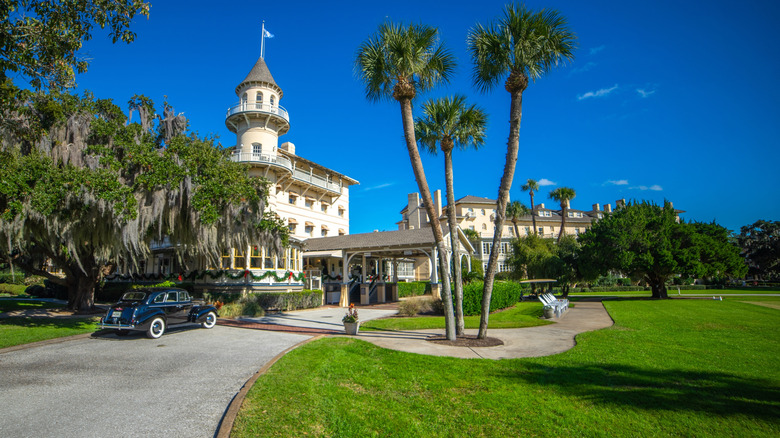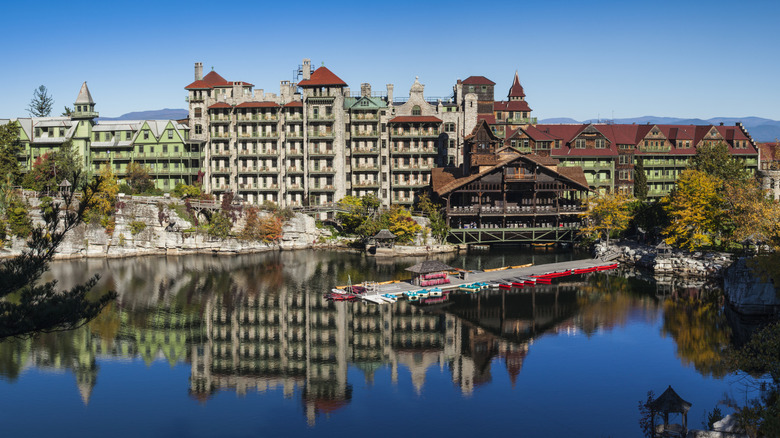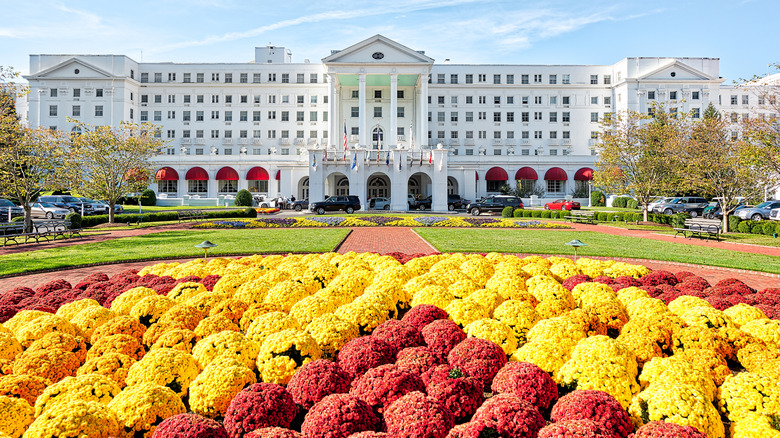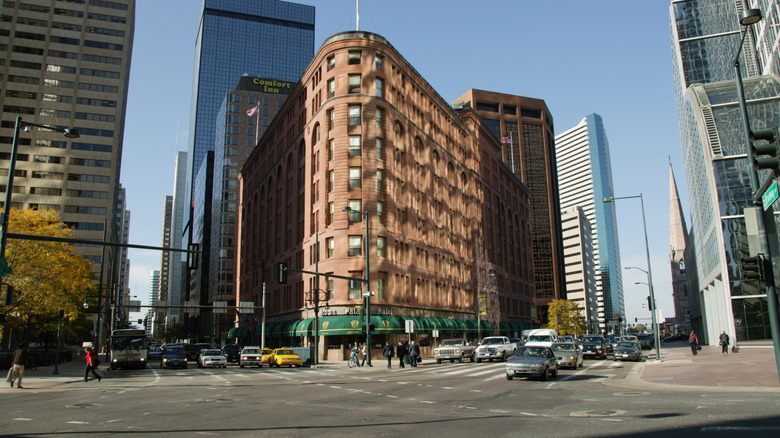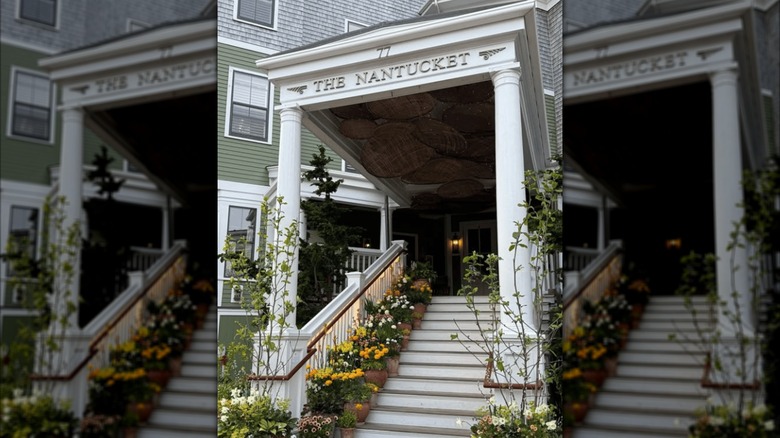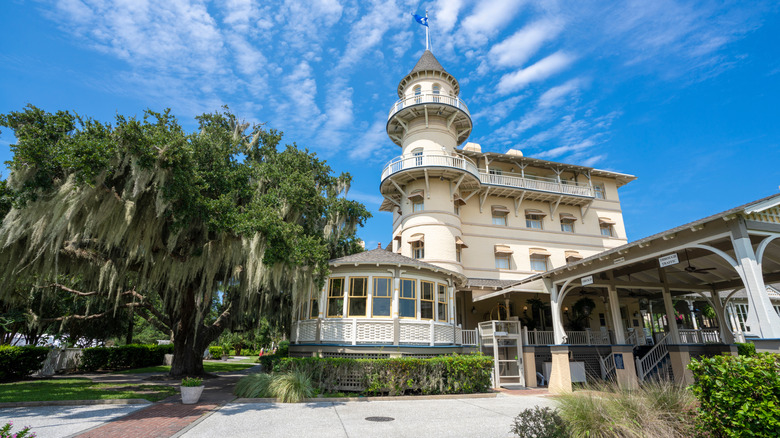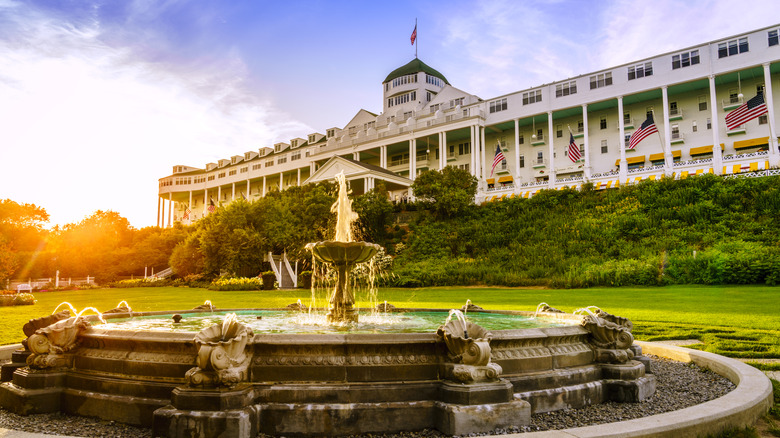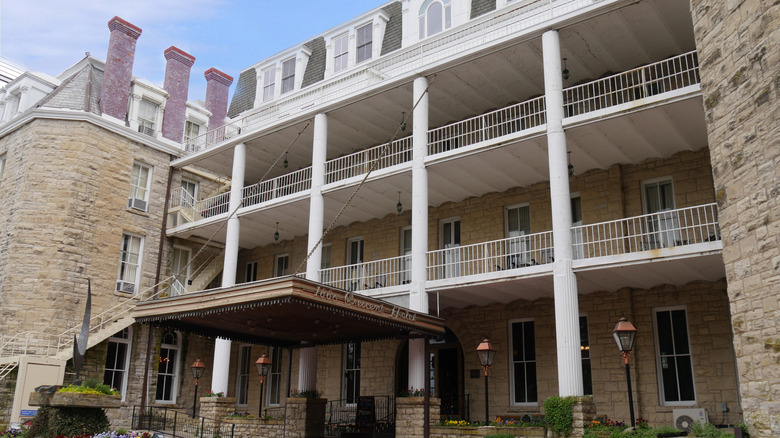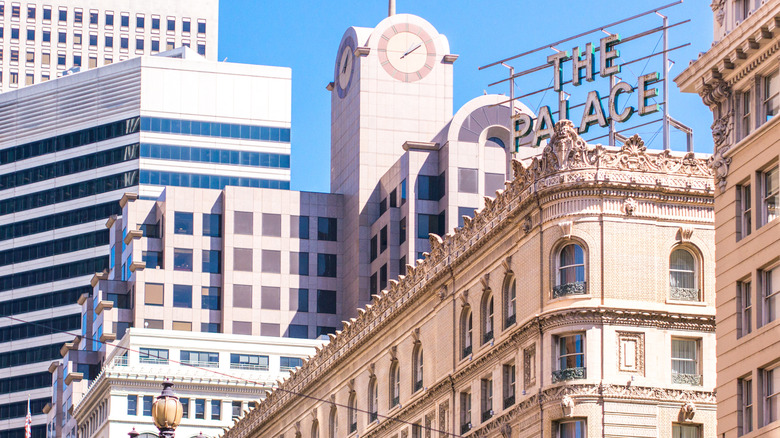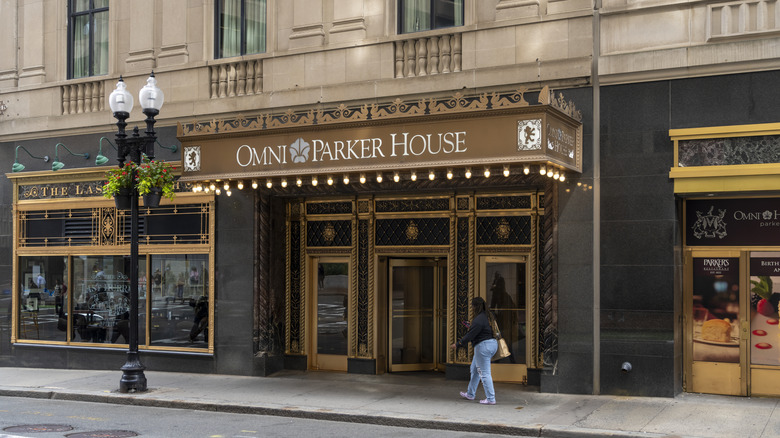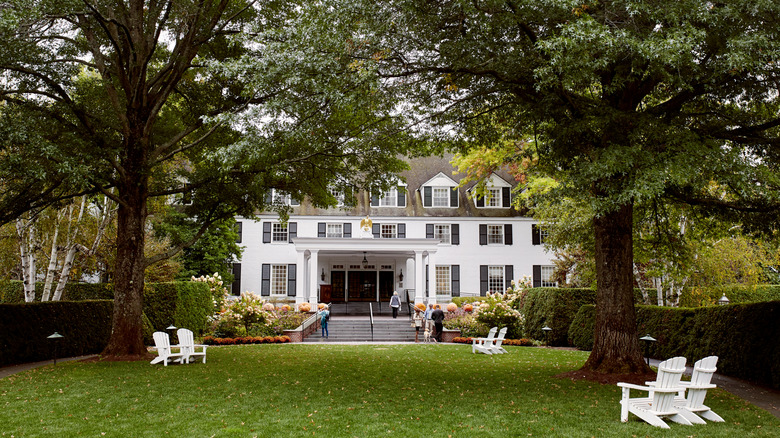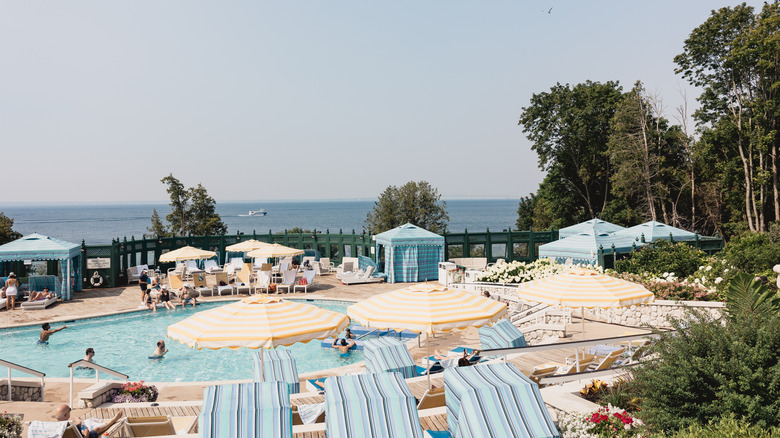Historic Victorian-Era Resorts And Hotels In America For A Luxurious Summer Vacation
Forget your sparkly nightclub gear, because the look for this summer is petticoats, corsets, and big bustles. That's right — we're time-traveling back to the Victorian era to explore some of the most luxurious and historically fascinating resorts and hotels across America. While the country is littered with sleek high-rises and boutique hotels, these lodges harken back to a time when luxury meant more than chocolates on pillows.
The Victorian era, which began in 1837, was known for its grandeur and opulence. It wasn't until 1901 — when Britain's Queen Victoria passed away — that the so-called Victorian era came to an end. Although it was geographically separated from the halls of Buckingham Palace, America experienced a boom in the hospitality industry during this time. And from the cobblestoned streets of Boston to the sleepy, southern gothic coasts of Georgia, many of these lush hotels and resorts are still standing today.
To help make your summer vacation an extra indulgent escape, we dove into the archives to uncover the country's finest surviving Victorian-era stays. Whether it's lakeside luxury or farmhouse fancy, one thing you can be sure of is that these storied properties have been lovingly preserved and continue to offer world-class hospitality, just with a little more lace, velvet, and twinkling chandeliers than your average Airbnb.
Mohonk Mountain House in New Paltz, New York
Get ready to explore forests and Victorian-era interiors at this castle-like resort in the mountains. Located in New Paltz, New York, Mohonk Mountain House climbs out of the cliffside like something out of a European fairy tale. The sprawling estate dates back to 1869, when a man named Albert Smiley first purchased the 300-acre lot and transformed it into a recreational hotspot for the citizens of the Hudson Valley area.
Today, the 262-room hotel still casts its shadow over the dark blue waters of the lake located on its property, where visitors can enjoy excursions such as kayaking, fishing, paddle boarding, and even swimming when the summer heat kicks in. Like a lucky few of America's Victorian estates, Mohonk Mountain House has retained its original 19th-century beauty. However, like an even smaller number of these estates, the Mountain House is also still in the hands of the Smiley family.
A true family-operated business, the Smiley family has been overseeing the property ever since their descendant finalized his purchase in 1869. And yet, some of the features of the resort date back even further than that. If you visit Mohonk Mountain House in the summer, be sure to rent one of the rowboats available on the premises. These hand-built boats can be traced back to Lowell's Boat Shop, which originated in 1793. As the U.S.'s oldest operating boat dealer, it seems that Lowell's has teamed up with Mohonk to offer travelers the ultimate American history getaway.
The Greenbrier in White Sulphur Springs, West Virginia
Hidden in West Virginia's mountains is this living, breathing heirloom of American history. With its White House-like columns, pristine golf course, and charming cottages on the premises, the Greenbrier Resort is perfect for a summer getaway, particularly over Independence Day weekend. The estate was first carved out of West Virginia's Allegheny Mountains in 1778 when it was founded as a natural healing oasis.
Greenbrier's mineral springs continued to attract American travelers for decades, but it wasn't until the 1830s that the resort found its niche among wealthy Victorian guests. What was once a hippie escape suddenly became the hottest ticket in town for the upper echelon of American intellectuals, including politicians, judges, lawyers, diplomats, and other prominent figures. Standing at 2,000 feet, Greenbrier became known for its gorgeous mountain views and alpine air, offering a respite for many bluebloods who hailed from the humid southern states below.
What really certified Greenbrier's legacy as an iconic piece of American history was when it became a magnet for American presidents. In total, in the pre-Civil War era, five presidents stepped over its threshold. During the war, the giant estate was transformed into a hospital and command center. 1865 marked both the war's end and the reopening of the hotel's doors, with management not missing a beat. Today, Greenbriar remains a plush and prestigious institution. Visitors are invited to take full advantage of the Old White golf course, the on-site casino, infinity pool, and Victorian-style Lobby Bar.
The Brown Palace Hotel in Denver, Colorado
If you're looking for a historic stay on a trip to Colorado, the go-to place is the Brown Palace Hotel. This flatiron-style building juts out from the busy city streets of Denver, where the stone façade strikes a sharp contrast against the sleek, glass skyscrapers of today. First opening its doors on August 12, 1892, this Victorian-era hotel is a reminder of a bygone way of life.
The Brown Palace Hotel is a shining result of Colorado's Gold Rush history. With entrepreneurs flocking to the hills of the Centennial State in droves, it's no wonder that a business owner named Henry Cordes Brown ended up finding his fortune in the wilds of Denver. However, this man found metaphorical gold in the hospitality industry, purchasing acres of land in 1860 that would eventually become the Brown Palace Hotel.
Designed by the architect Frank E. Edbrooke, all hands were on deck to make this estate one of the most pristine stays in the state. Colorado red granite and Arizona sandstone were mingled to create the hotel's warm-hued frontage. As for the interior? The inspiration was the Italian Renaissance style, with another artist commissioned to carve 26 animal-shaped medallions to adorn the hotel at different points. Today, guests can see it all for themselves while also enjoying the modernized spa, salon, restaurant, and bar on site. Keeping on-theme with the vintage glamor, the Brown also provides throwback sounds with piano cabaret and music concerts weekly.
The Nantucket Hotel & Resort in Nantucket, Massachusetts
Perched on one of New England's most beloved islands, the Nantucket Hotel & Resort is a glorious time capsule wrapped in crisp white clapboard and coastal charm. Not only is this gorgeous estate Nantucket's only year-round hotel, but it's also an estate with deep roots in the Cape Cod community. The home was first purchased in 1888 by a man named Charles F. Folger, and was eventually unveiled as the Point Breeze Hotel in the summer of 1891.
It wasn't until 2012 that it was renamed the Nantucket Hotel & Resort, but even though the moniker may have shifted, this pastel-hued and breezy estate has not lost its Victorian charm. One of the most impressive suites in the hotel is named the Folger Grand Suite, acting as a subtle shoutout to the original godfather of the resort. Additionally, the seaside comfort turns adventurous with an invitation for visitors to climb aboard the historic ship, the Lynx.
With 19th-century sails and American flags waving in the breeze, one will feel like they've been transported directly to the 1880s when they ride past the harbors and hydrangeas of Nantucket aboard this architectural wonder. That's not all; in addition to the spacious rooms and unique day trips, guests at the Nantucket Hotel & Resort are also able to take advantage of antique vehicle rides, yoga classes, poolside fun, and beach shuttles that drive you directly to the white sand beaches of gorgeous (and vintage) Cape Cod.
Jekyll Island Club Resort in Jekyll Island, Georgia
Georgia's best secret vacation spot is this coastal hideaway dripping in Spanish Moss trees and just a stone's throw away from Savannah. Jekyll Island Club Resort is the beating heart of this tiny barrier island, jutting out into the Atlantic coast. Jekyll Island first got its name in 1733 when the English colonist General James Oglethorpe landed on Georgia's shores. However, it wouldn't be until 1888 when the island's Club Resort opened its door, catering exclusively to some of the wealthiest families in America.
From golfing among the dunes to clinking glasses with guests with last names like Rockefeller, Morgan, Vanderbilt, and Pulitzer, summers at the Jekyll Island Club Resort were, and still are, legendary. Between the garden-party-ready lawns and the Italian Renaissance-inspired cottages, it's no surprise that many Hollywood films have chosen this resort as a filming location. Look closer next time you watch "X-Men: First Class" or "Glory," and you just might recognize those rotunda rooms and lighthouse towers.
Today, the Jekyll Island Club Resort is open to everyone, not just the wealthy elite or those who have film crew passes. Guests who choose this Victorian-era stunner as the backdrop to their summer adventures will delight in indoor tennis courts, oceanfront views, and a property that practically sings with history. The resort completed a full renovation project in 2024, meaning that, despite its long-ago birth year, this hotel is brighter and better than ever.
The Grand Hotel in Mackinac Island, Michigan
One of Michigan's most gorgeous old-school hotels is the Grand Hotel on Mackinac Island. The supersized estate certainly lives up to its name, boasting a dreamy white-washed porch that has been crowned the longest in the world, measuring an eyebrow-raising 660 feet. Crisp white railing and lakeside view of the Straits of Mackinac come together to serve up an epic serving of Victorian grandeur and Midwest vigor.
The ribbon was first cut on the Grand Hotel in 1887 as an alternative to the more cramped summer getaways on Mackinac Island. With its abundance of space and multitude of rooms, the Grand Hotel took off like a rocket among travelers from the nearby cities of Chicago, Montreal, Detroit, and Erie. By steamer and rail, people flocked to the island to take advantage of the hotel's prime lakeside location and classic American glamor. Believe it or not, it only cost these early visitors $3.00 to $5.00 per night to stay.
Today, the Grand Hotel is a bit pricier, but the level of sophistication has yet to dip below its original high standards. The National Historic Landmark continues to draw summertime visitors every year, drawing folks in with its period-piece romanticism. The impressive front porch still glows with memories of parasol-shaded walks of years past, and it is still a popular pastime to take your lover for a "Flirtation Walk" down the path, a charming relic of the hotel's Victorian past.
1886 Crescent Hotel & Spa in Eureka Springs, Arkansas
One of the most underrated historical gems in Arkansas is this storied resort tucked away in the green hills of Eureka Springs. As its name suggests, the 1886 Crescent Hotel & Spa was originally constructed in the latter half of the 19th century and has been welcoming summering visitors ever since. When it first opened its doors, the Crescent was a hotspot for wealthy adventurers who found themselves in the Natural State.
The town of Eureka Springs, which itself was only established in 1879, soon earned a reputation for spiritualism and healing hot springs. Native Americans were the original practitioners of these practices, but white settlers soon followed, and the Crescent Hotel & Spa wasted no time in cashing in on the influx of curious visitors looking for a cozy spot to decamp in this mystical town.
Today, the 1886 Crescent Hotel & Spa (as it has been renamed) is just as famous for its calming views of the Ozark Mountains as it is for the ghost stories that have attached themselves to the rocking-chair-dotted balconies and grand mahogany suites of the hotel. Spooky tales of the hotel's past residents and workers from the Victorian period have been passed around online like contraband wine. One chilling story tells of a stone mason who supposedly passed away while building the hotel and now haunts room 218. So if you're looking for an out-of-the-box summerween vacation, this haunted Victorian wonder could be your next stop.
Palace Hotel in San Francisco, California
The essence of classic San Francisco is captured in this gold-gilt inn, rightly dubbed the Palace. It doesn't get much more luxurious than this elegant seven-story hotel, where everything is drenched in champagne hues and sunlight. Walk through downtown San Francisco and it's hard to miss; this unique building has stood in the same spot since it first opened in 1875.
The Palace quickly became a watering hole for California's finest, from artists to aristocrats to U.S. presidents; Ulysses S. Grant, William McKinley, and Theodore Roosevelt all dined and slept in these lavish rooms. One of the most impressive features of the hotel, both then and now, is the area known as the "Grand Court." It's here where you'll find the hotel's iconic skylight and European-inspired columns. It's believed that the Grand Court was built to such wide dimensions so guests' horse-drawn carriages could drive directly onto the premises. Royal treatment, indeed.
While you're more likely to hear car horns than horse hooves today, you can still expect to be treated like a Rockefeller during your stay. The hotel's calendar is filled with celebratory events, from afternoon tea to whiskey tastings and a Pride-themed breakfast buffet in honor of San Francisco's LGBTQ history. If it's more history than posh pampering you're after, then you'll be thrilled to hear that the Palace also offers a free on-site museum — Landmark 18 — that includes fascinating photos and archives from the hotel's history.
Mount Washington Resort & Spa in Bretton Woods, New Hampshire
Woodland adventures and spa days are at your fingertips at this New Hampshire stay. However, when you're done ziplining or have had enough of the sauna, you might find the hotel's history just as entertaining. Constructed on the tail end of the Victorian era, this palatial, crisp mansion was erected between 1900 and 1901 as the joint project of railroad magnate Joseph Stickney and architect Charles Alling Gifford.
Built across hundreds of acres of land in the Mount Washington area, this Y-shaped inn had been a dream project of Stickney and Gifford's since the 1880s. The visionaries spared no expense, and when the hotel was complete, they had spent over $1.5 million ($52 million today) in making the Mount Washington Resort & Spa the grandest it could possibly be. Wealthy visitors came in wagon-loads. It's easy to imagine the mustachioed gentlemen promenading through the gardens with their smoking pipes while corseted ladies read the latest Oscar Wilde poem in an Adirondack chair.
You can recreate these scenes yourself, as the Americana architecture and natural sights are still the same today as they were at the turn of the century. Pick a room with a view of the titular Mount Washington — the highest peak in the entire state of New Hampshire — or book a stay in the hotel's Presidential Wing, where a private concierge will make you feel as if you're a guest of a railroad magnate circa 1901.
Omni Parker House in Boston, Massachusetts
Step over the threshold of the Omni Parker House, and you're walking into living history with a velvet finish. Nestled along a downtown street in Boston, Massachusetts, this glamorous spot is America's longest continuously operating hotel. Thankfully, it wears its age like a badge of honor.
The (revolving) doors were first opened in 1855, and the Parker House quickly became the go-to place to stay among Boston's literary giants, including Henry Wadsworth Longfellow, Ralph Waldo Emerson, and the author of "The Scarlet Letter," Nathaniel Hawthorne. In fact, one of the era's most popular authors and the very prototype of a Victorian gentleman, Charles Dickens, gave his first public reading of "A Christmas Carol" here. And the "firsts" don't end there; Omni Parker House also claims the invention of the regional delight, the Boston Cream Pie.
As the birthplace of the official Massachusetts state dessert, is it any surprise that this historical marvel has been given prime place along the Boston Freedom Trail? So, whether you're indulging in literary nostalgia or sampling a slice of culinary fame, the Omni Parker House delivers Victorian-era prestige with just the right amount of modern charm.
Woodstock Inn & Resort in Woodstock, Vermont
You might associate Victorian gentlemen and ladies with urban mansions and sprawling, gold-gilt estates, but, in reality, the country estate played an important role in Victorian high society. It was here that moneyed men and women summered in peace, loosening their corset strings to swim and smoke in private. For some, that meant even conducting torrid extramarital love affairs — definitely a big no-no in Victorian society.
One of these rural gems that was the site of these adventures is still standing in the hamlet of Woodstock, Vermont. Founded by Laurance and Mary Rockefeller, the Woodstock Inn & Resort was built on the site of an even older hotel (we're talking 1700s) in 1892. With over 100 rooms and a 400-foot-long patio, this grand, white-washed inn paired country aesthetics with the size needed to accommodate the size of New England's upper echelon.
The parties thrown on the premises were so legendary that they made the news in cities as far away as Boston and Montreal. So why not recreate these summer memories for a newer generation? The Woodstock Inn & Resort is still standing and welcoming guests, whether you're history-obsessed or just looking for a good time.
Methodology
To pinpoint the most luxurious Victorian-era resorts across America, we donned our monocles to dive deep into the archives, exploring the country's oldest hotels. By analyzing the historical preservation lists reported by organizations like Historic Hotels and Smithsonian Magazine, we were able to unearth some of the top stays whose roots in the past have not diminished their modern-day luxury.
To be included on our list, each location had to tick off a series of criteria: date back to the Victorian era, which lasted from 1837 to 1901, uphold architectural authenticity from this sepia-toned period, and, finally, boast refreshed, up-to-date amenities that will ensure visitors will be taken care of during their stay. The result? A curated list of timeless escapes that will be a history buff's dream come true.
